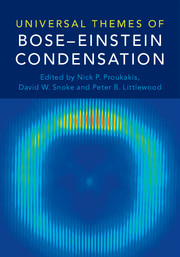Book contents
- Frontmatter
- Contents
- Foreword
- Preface
- Part I Introduction
- Part II General Topics
- Part III Condensates in Atomic Physics
- Editorial Notes
- 13 Probing and Controlling Strongly Correlated Quantum Many-Body Systems Using Ultracold Quantum Gases
- 14 Preparing and Probing Chern Bands with Cold Atoms
- 15 Bose-Einstein Condensates in Artificial Gauge Fields
- 16 Second Sound in Ultracold Atomic Gases
- 17 Quantum Turbulence in Atomic Bose-Einstein Condensates
- 18 Spinor-Dipolar Aspects of Bose-Einstein Condensation
- Part IV Condensates in Condensed Matter Physics
- Part V Condensates in Astrophysics and Cosmology
- Universal Bose-Einstein Condensation Workshop
- Contributors
- Index
- References
18 - Spinor-Dipolar Aspects of Bose-Einstein Condensation
from Part III - Condensates in Atomic Physics
Published online by Cambridge University Press: 18 May 2017
- Frontmatter
- Contents
- Foreword
- Preface
- Part I Introduction
- Part II General Topics
- Part III Condensates in Atomic Physics
- Editorial Notes
- 13 Probing and Controlling Strongly Correlated Quantum Many-Body Systems Using Ultracold Quantum Gases
- 14 Preparing and Probing Chern Bands with Cold Atoms
- 15 Bose-Einstein Condensates in Artificial Gauge Fields
- 16 Second Sound in Ultracold Atomic Gases
- 17 Quantum Turbulence in Atomic Bose-Einstein Condensates
- 18 Spinor-Dipolar Aspects of Bose-Einstein Condensation
- Part IV Condensates in Condensed Matter Physics
- Part V Condensates in Astrophysics and Cosmology
- Universal Bose-Einstein Condensation Workshop
- Contributors
- Index
- References
Summary
Selected topics on spinor-dipolar aspects of Bose-Einstein condensation are overviewed. Spinor aspects include spin correlations, fragmentation, dynamical symmetries, and quantum mass acquisition. Dipolar aspects include magnetostriction, d-wave collapse, roton-maxon spectrum, supersolidity, and ferrofluidity. Finally, spinor-dipolar aspects concern the Einstein–de Haas effect and spontaneous mass and spin currents in the ground state.
Introduction
Bose-Einstein condensation is a phenomenon in which a macroscopic number of particles occupy the same single-particle state as a consequence of symmetrization of a many-body wave function and thereby quantum effects are amplified to the macroscopic level. The amplified single-particle state serves as a complex order parameter whose phase behaves as an emergent thermodynamic quantity, with its temporal and spatial variations giving the chemical potential and the superfluid velocity, respectively. If the interparticle interaction is repulsive, a Bose-Einstein condensate (BEC) acquires stability against excitations out of the condensate because they would cost the Fock exchange energy. This rigidity of the order parameter or the condensate wave function endows a BEC with several remarkable transport properties which are collectively known as superfluidity. In particular, the superfluid fraction can be 100% at zero temperature even though the condensate fraction is depleted due to interparticle interactions. Interparticle interactions also make excited particles phase-locked to the condensate, leading to Bogoliubov quasiparticles, which are the manifestation of phase-coherent particle– hole excitations.
When constituent particles have spin degrees of freedom, a BEC features magnetism and spin nematicity which conspire with superfluidity to produce a rich phase diagram. In the absence of an external magnetic field, the mean-field groundstate phase diagram includes two [1, 2], five [3, 4, 5], and eleven phases [6, 7] for spin-1, 2, and 3 BECs, respectively. BECs with spin degrees of freedom are called spinor condensates. Moreover, the magnetic dipole–dipole interaction (MDDI) between atoms lends distinct twists to spinor condensates because it is long-ranged and anisotropic in sharp contrast with other interactions, which are short-ranged and isotropic. In this chapter, we will present a brief overview on the spinordipolar aspects of BEC. An early experimental work of spinor BECs is reviewed in Ref. [8]. Later developments with an emphasis on theoretical aspects are described in Ref. [9]. Many-body physics of polarized dipolar gases is reviewed in Ref. [10].
Information
- Type
- Chapter
- Information
- Universal Themes of Bose-Einstein Condensation , pp. 371 - 386Publisher: Cambridge University PressPrint publication year: 2017
